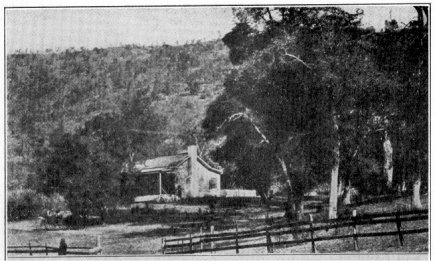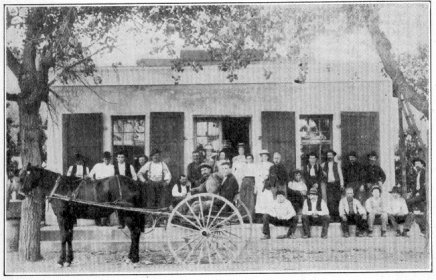
[click to enlarge]
The Frémont College in Bear Valley in 1858.
[Editor’s note: from p. xi: The Fremont “White House”, in Bear Valley, 1858. —dea].
| Online Library: | Title | Author | California | Geology | History | Indians | Muir | Mountaineering | Nature | Management |
Yosemite > Library > Call of Gold > 16. Fremont’s Political and Mining Activities >
Next: 17. 1857 Trial • Contents • Previous: 15. Galen Clark
In 1851, Fremont was a candidate for re-election as U. S. Senator and was supported by the Free State party. The pro-slavery element was too strong and his defeat resulted. He spent a great deal of his time this year on his Mariposa Estate, from which his income was large, even though squatters and claim jumpers had taken possession of, and were mining, many rich portions of it. His Mexican miners were so harassed that they finally left, but not without turning over to him several sacks of gold.
The title to his land had not been confirmed and the miners believed that, even if confirmed, he would be entitled only to agricultural uses of the land, except where he had filed mineral claims, as under the Mexican law, under which the Grant was first made, the minerals were not actually conveyed, but remained the property of the Government.
In 1852, he presented his claim to the U. S. Board of Land Commissioners, who confirmed his title, according to the survey, which he, himself, had made. On appeal to the U. S. District Court, the decision of the Board was reversed and his lawyers immediately appealed the case to the U. S. Supreme Court.
In the latter part of 1852, he went East, then to England and France, returning to America the following year in order to start a winter expedition in continuance of his former efforts to find the most suitable route for a transcontinental railroad from the Atlantic to the Pacific.
In December 1854, the U. S. Supreme Court remanded his case back to the District Court, declaring the claim valid and ordering an official survey. In June, 1855, the District Court gave a final decree and in July, the boundaries of his estate were fixed by an official survey under the direction of the Surveyor-General of the United States for California, which survey included the Mt. Ophir mine and others, hitherto unclaimed by him.
A patent was issued on the part of the United States to him, bearing the date, February 19, 1856, signed by the President of the United States, countersigned by the Acting-Recorder of the General Land Office, in Washington, and worded, “In pursuant to the provisions of the Act of Congress, approved on the 3rd day of March, 1851, entitled ‘An Act to Settle the Private Land Claims in the State of California’.” Thus, the boundaries of his property were fixed permanently and with no reservations specified.
The official survey will always remain a mystery as to why rich mines were given to him, which he had never claimed. At the time of the official survey, it was still undetermined whether the title to the minerals went with the title to the land, so, it is possible, that the Surveyor-General and his agents may have so shaped the survey as to make it a desirable cattle ranch. The most plausible reason is that some of Fremont’s own agents used means to influence the shaping of the survey, without his knowledge.
It was impossible for a man of Fremont’s nature, a dreamer with no business training, to manage his kingdom alone. He placed the details of its management with agents and lessees. As early as 1849, he had engaged the help of Palmer, Cook & Co., bankers and politicians, and this firm had organized the Mariposa Mining Co., in 1850, working under a lease from him. With his income, plus advance loans made to him by his bankers, he traveled extensively and lived and entertained like a king.
Those who knew him intimately always felt that he, personally, had nothing to do with the inclusion of valuable mines, which for years had been claimed and operated by others, in the official survey. His integrity was unquestioned and he was not avaricious. Some of his friends suggested that he work his mines with slave labor, that by so doing, he would become extremely wealthy, but he refused, saying that if he couldn’t make money fairly, he would do without it. He was entitled to approximately 44,000 acres of land, and as the whole country had been taken up by

[click to enlarge] The Frémont College in Bear Valley in 1858. [Editor’s note: from p. xi: The Fremont “White House”, in Bear Valley, 1858. —dea]. |

[click to enlarge] Marre store, Mt. Bullion, built in 1862. |
In 1856, he was made the first candidate for the Presidency of the United States, by the newly organized Republican party. He was also nominated by the National American convention for the same office. During the campaign, his opponents did a tremendous amount of mud-slinging to belittle his accomplishments. He was defeated at the election, receiving 114 electoral votes as against 174 for Buchanan and 8 for Fillmore. Strange to say, he carried the Democratic State of New York by a large majority and the popular vote throughout the Nation, in his favor, was very large.
On April 22, 1857, he leased the Mt. Ophir property, which had been given him by the official survey, to Biddle Boggs for seven years, at a monthly rental of $1000. The property was in the possession of the Merced Mining Co., who had entered into possession of the premises in May, 1851, under a quit-claim from Moffat, the Assayer, and believed they were on Government land. They had erected thereon, at great expense, estimated at $800,000, machinery, mills etc. and had continued in the occupation of the premises, working the quartz veins and extracting gold. Fremont had never claimed any land within one or two miles of their property. They maintained that the official survey had been made in a clandestine manner and that he had no title to the minerals, as his Grant was for grazing and agricultural purposes only.
Next: 17. 1857 Trial • Contents • Previous: 15. Galen Clark
| Online Library: | Title | Author | California | Geology | History | Indians | Muir | Mountaineering | Nature | Management |
http://www.yosemite.ca.us/library/call_of_gold/fremonts_activities.html